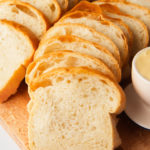
Sandwich Bread
This easy, soft sandwich bread recipe makes two perfectly golden loaves of white bread. Trust me, you're going to thank me later.
Ingredients
- 6½ cups bread flour
- 2 cups lukewarm water (may substitute with 1 cup of milk and 1 cup of water)
- 4 Tablespoons unsalted butter softened
- 2 Tablespoons honey
- 3 teaspoons instant yeast
- 3 teaspoons sea salt
- 1 Tablespoon unsalted butter for brushing on the bread
- 1 Tablespoon unsalted butter for the loaf tins
Instructions
- IMPORTANT READ: I suggest using metric measurements and weighing the dry and wet ingredients for best accuracy. Toggle between US customary and metric buttons above in the ingredients section for exact flour weight in grams. If you don't have a scale, use a fork to fluff the flour, then spoon the flour into the cup. Never pack or scoop.
- Add the dry ingredients into a stand mixer bowl. Use the dough hook attachment. Note: Toggle between US customary and metric buttons above in the ingredients section for exact flour weight in grams.6½ cups bread flour, 3 teaspoons instant yeast, 3 teaspoons sea salt
- While the mixer is on, slowly add the water, butter and honey. Knead on slow speed for 5-7 minutes until the dry and wet ingredients are fully incorporated, smooth and combined. The dough will start pulling away from the sides of the bowl. The dough will feel tacky but not sticky. Oil your fingers to make handling the dough more manageable.2 cups lukewarm water (may substitute with 1 cup of milk and 1 cup of water), 4 Tablespoons unsalted butter, 2 Tablespoons honey
- Remove the dough from the edges of the mixing bowl, form into a round shape and place back into the bowl. Lightly drizzle the bowl edges and dough with oil. This prevents the dough from getting stuck on the edges when rising. Cover with plastic wrap and place in a warm spot for 2 hours until doubled in size. This first rise is called bulk fermentation. It allows the yeast to ferment the dough, developing flavor and helping the gluten structure form.
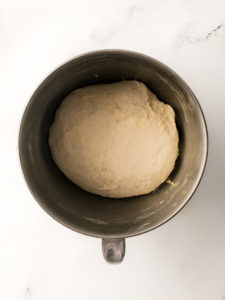
- Prepare each 1lb. loaf tin by spreading softened butter on the entire inside surface. Set aside.1 Tablespoon unsalted butter
- Punch the dough down and transfer to a clean, dry work surface. Do not add flour.
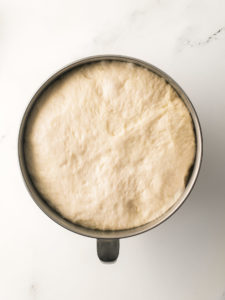
- Divide the dough equally in half, about 670g each. Use a scale for best results. Weigh the entire dough ball, then divide that number by half.
- Flip over so the smoother side is down. Working with one dough piece at a time, use your fingertips to gently flatten the dough into a rectangle, about the same width as the loaf tin.
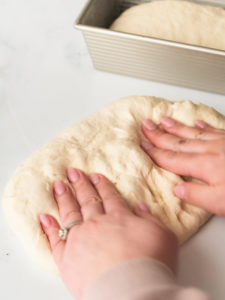
- Roll the portion closest to you up and away from you.
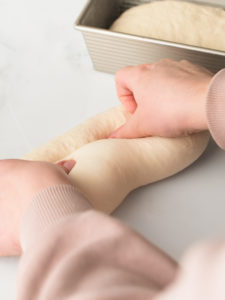
- Then, fold the sides towards the center and continue rolling away from you, forming into a small log shape. Use the resistance of the surface to pull the dough tightly together. Gently pinch a seal where the edges come together.
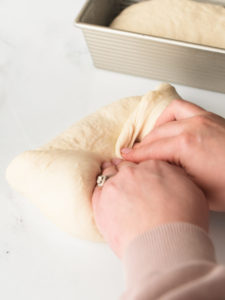
- Place each dough log into the loaf tin, seam side down. Gently press down the surface of the dough into the loaf tin to release any surface bubbles.
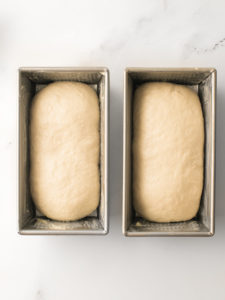
- Loosely cover with plastic wrap and let it rise for at least 40 minutes but up to one hour, depending on the temperature of the room. The dough will rise above the edges of the loaf tin. This second rise is called proofing. It occurs after the bread is shaped. This shorter rise allows the dough to develop a little more volume and improves the final structure.
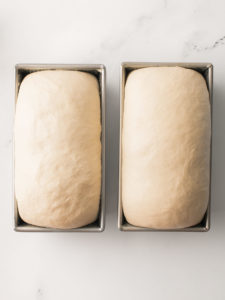
- While the dough is rising in the loaf tins, preheat the oven to 350°F / 176°C.
- Remove the plastic wrap and bake for 40-42 minutes until deeply, golden brown. Brush with butter over the tops of the loaves. This helps keep the crust soft and adds a finishing touch. Leave the bread in the tin for at least 10 minutes, then transfer to a rack to cool.1 Tablespoon unsalted butter
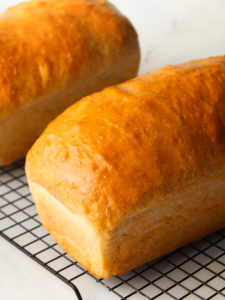
- This bread is very soft and fluffy. Slice when completely cool for best results and store leftovers at room temperature for up to 3 days.
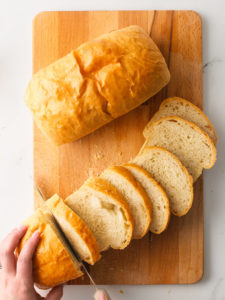
Video
Notes
- If using active dry yeast, first measure 240ml or 1 cup of the warm water in a wide mouth cup or bowl. Add in a teaspoon of sugar and sprinkle the yeast on top. Whisk together to combine and let it sit for 5-10 minutes until foamy and bubbly on top. Then, add to the dry ingredients, along with the remainder of the water and proceed with baking directions. For extended instructions, see Active Dry Yeast vs. Instant Dry Yeast blog post.
- Measure flour by weight in grams instead of cups. Shop my exact scale here. (affiliate link) If you don't have a scale, fluff the flour with a fork in its container, and then spoon it into the measuring cup before leveling off with a flat edge. Do not scoop directly into the flour bag. This will add way too much flour to the batter, making it dry!
- Store at room temperature: This bread is super soft, even the second day. Generally speaking, homemade bread doesn't last longer than a few days because it doesn't contain any preservatives. Store leftovers tightly closed in a brown paper bag or Ziploc.
- Store in the freezer: Wait until the loaf is completely cooled. Then, simply slice to your desired thickness and place in a freezer safe bag. Store in the freezer for up to one month. I love using frozen leftovers for toast or toasted sandwiches.
- Never store in the refrigerator: Do not store bread in the refrigerator. It will cause your bread to become stale and dry faster. It holds well at room temperature with the right precautions.
Nutrition
Calories: 252kcalCarbohydrates: 43gProtein: 8gFat: 6gSaturated Fat: 3gPolyunsaturated Fat: 1gMonounsaturated Fat: 1gTrans Fat: 0.2gCholesterol: 12mgSodium: 468mgPotassium: 80mgFiber: 2gSugar: 2gVitamin A: 141IUVitamin C: 0.02mgCalcium: 11mgIron: 1mg
The provided nutritional value above is an estimate per serving. 100% accuracy is not guarenteed. Please see Nutrition Information Disclaimer in our Privacy Policy.
Nutrition Information Disclaimer Have you tried this recipe?Please leave a comment/review below!